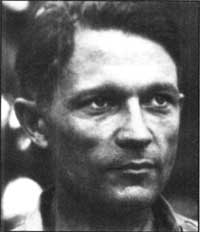| The War in the Pacific |
|
LIBERATION — Guam Remembers A Golden Salute for the 50th anniversary of the Liberation of Guam Symbol of hope, controversy When the Argentina Maru sailed from Guam on Jan. 10, 1942, all American prisoners of war were accounted for except six Navy sailors: A. Yablonsky, yeoman first class; L.W. Jones, chief aerographer; L.L. Krump, chief machinist mate; C.B. Johnston, machinist mate first class; Al Tyson, radioman first class; and perhaps the most famous of the group - George Tweed, also a radioman first class. Only Tweed survived the war, thanks to the dozens of people who harbored him during the 30-month occupation period. Krump, Jones and Yablonsky were discovered in the Manengon area in September 1942 and were beheaded by the Japanese. Later, Tyson and Johnston were found and shot in Machananao.
But it was Tweed that was a thorn in the side of the Japanese ... and the Chamorros. To both Japanese and Chamorros, Tweed represented the United States, but in vastly different perspectives. To the Japanese, he was a threat and a sore point in their desire to extinguish the influences of America upon Guam. To Chamorros, Tweed could be seen two ways. In one perspective, he did indeed represent the United States; his presence and continued existence symbolized hope in America's return to Guam. As a result, many people aided him to evade capture by members of the Minseibu, the policemen and investigators of the Japanese naval militia charged with civilian affairs on Guam. Those who felt this way cited a responsibility to the United States in helping Tweed keep his freedom. The second perspective was less kind: Tweed was willing to allow Chamorros to suffer and die as he lived in freedom in the jungles of Guam. Those of this second view note, in their opinion, Tweed's lackadaisical attitude in staying hidden, often looking for better shelter and sometimes for female companionship. Authorities tried all through the occupation to arrest the Navy radioman. Questioning many, torturing some, Japanese authorities did indeed execute people, using Tweed as a rationale. As U.S. forces approached Guam, the efforts to capture him intensified. Among those executed just prior to the July 21 liberation was the popular Catholic priest, the Rev. Jesus Baza Duenas. Despite the brutalities inflicted upon the local populace, the secret of Tweed was kept just that ... a secret. All Japanese efforts to capture him failed. Tweed, who was then living in a cave overlooking the northwest coast of Guam, eventually signaled a Navy destroyer, the McCall, which was shelling the island prior to the July 21 invasion. Picked up by a small boat from the ship on July 10, Tweed was probably the first person in Guam to be actually liberated from the Japanese occupation by U.S. forces.
|
